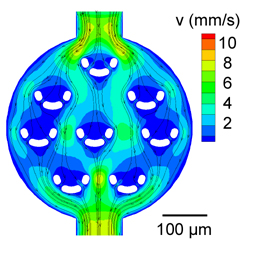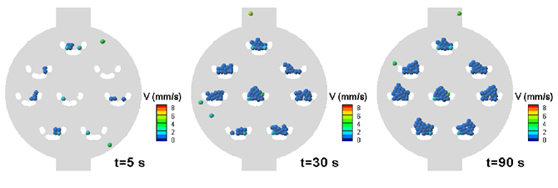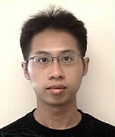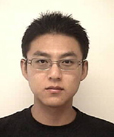
In the engineering of microfluidic devices for biological applications, the need clearly exists for good modeling to avoid the expensive pitfall of iterative trial-and-error based design. Understanding the underlying physics of fluid flow at the microscale is inherently useful, as parameters such as pressure drop, shear force, and slip at the microchannel surface can be significant, depending on the microchannel dimensions.
Microscale fluid dynamics, particularly with respect to microchannel geometry, are particularly relevant in the design of microfluidic devices for cell biology, as strong shear forces compromise cell integrity. The Thorsen group has been utilizing computational fluid dynamics (CFD) as a tool to model flow for both cell-based diagnostic and screening devices and larger, integrated microscale platforms such as artificial respiration. For our cell-based cytotoxicity platform (see related project link), a microchamber was modeled containing an array of U-shaped sieves to trap a small population of cells (~10/sieve). To model the cell trapping process, CFD was used to obtain a flow map of the local fluid velocity using Finite Volume Method around and through the sieves. Momentum equations and continuity equation were solved using SIMPLE (Semi-Implicit Method for Pressure Linked Equation) algorithm. Within the simulation, the transient motion of every cell was calculated by using one-way coupled Lagrangian approach for the pre-computed Newtonian flow fields. This includes spatial interpolation of the flow velocity at the cell’s position. Each cell was assumed to be a solid sphere with a hydraulic diameter of 10µm, and the forces considered in the equation of motion for the cells were the Stokes drag, the pressure gradient, diffusive and buoyant forces, and a spring force to model the elastic collision between cells. Results from the simulation were used to optimize the position of the individual sieves within each microchamber, resulting in the uniform trapping of cells within each sieve.
  |
Modeling of flow parameter such as pressure drop, fluid viscosity, and shear forces has also been applied to our artificial respiration project. The development of microfluidic devices designed to emulate physiological flow systems, such as the capillary microcirculation, has particularly stringent design requirements due to the need to maintain the viability of rather fragile red and white blood cells. Such microchannels need to incorporate a relatively small diffusive boundary layer to allow chemical efficiency while maintaining broad enough dimensions to minimize adverse flow conditions. As a basic, scalable building block to minimize damaging tangential shear forces, we adopted an asymmetrically configured microchannel network design. Using CFD, we simulated the flow of blood through the microchannel configuration, modeling both flow viscosity and flow velocity. From this model, we were able to develop a model that correlated microchannel dimension and volumetric flow rate with the percentage of blood hemolysis resulting from passage through the device that correlated well with experimentally fabricated modules (Ref 7).
 |
In addition to modeling the dynamics of the fluid in microchannels, we are very interested in mass transport of materials in microchannels, including both biological materials such as DNA as well as gas transport by diffusion and convection for cell culture and artificial respiration. We have developed analytical models for microchannel oxygenation (Ref 1) and DNA hybridization (Ref 2), modeling low aspect ratio microchannels as infinite parallel plates, that correlate well with values obtained in experimental devices fabricated in the laboratory. We are continuing to refine these models using CFD to refine these models for more complex microchannel shapes. Recent collaborative work with Prof. Seth Fraden at Brandeis has also investigated the transport of materials such as water through PDMS microchannels to study dynamic droplet wetting and drying in two-phase microfluidic devices, with applications in protein crystallography (Ref 6).
Present Post-Doctoral Fellows
 |
Dr. Min-Cheol Kim |
Dr. Marco Rasponi |
Present Graduate Students
 |
Raymond Lam (Doctoral Student) |
 |
Hyesung Park (Doctoral Student) |
Present Undergraduate Students
Visitors
Alumni
 |
Adam Vollmer (Masters, S.M., June 2005) Thesis Title: "Development of an integrated microfluidic platform for oxygen sensing and delivery" |
Collaborators
Richard Gilbert, M.D., Dept. of Mechanical Engineering, M.I.T.
Prof. Ronald Probstein, Dept. of Mechanical Engineering, M.I.T.
Prof. Alberto Redaelli, Dept. of Bioengineering, Politecnico Milano
Prof. Seth Fraden, Dept. of Physics, Brandeis University
Sponsors
National Institutes of Health (1-RO1-HL086652-01)
MIT-Milan Politecnico Alliance (Progetto Roberto Rocca)
Korean Advanced Institute of Science and Technology (KAIST)
Refereed Publications and Conference Proceedings
1. A.P. Vollmer, R.F. Probstein, R. Gilbert and T. Thorsen. Development of an integrated microfluidic platform for dynamic oxygen sensing and delivery in a flowing medium. Lab Chip 5: 1059-1066 (2005) (PDF)
2. J.A. Benn, J. Hu, B.J. Hogan, R.C. Fry, L.D. Sampson, and T. Thorsen. Comparative modeling and analysis of microfluidic and conventional DNA microarrays. Anal. Biochem. 348: 284-293 (2006) (PDF)
3. Z. Wang, M.-C. Kim, M. Marquez, and T. Thorsen. High-Density Microfluidic Arrays for Cell Cytotoxicity Analysis. Lab Chip 7: 740-745 (2007) (PDF)
4. M.-C. Kim, Z.H. Wang, R.H.W. Lam and T. Thorsen. Simulation of biological cell transport in microfluidic devices. Nanotech 2007. Santa Clara, CA. May 23, 2007.
5. Z.H. Wang, M.-C. Kim, M. Marquez and T. Thorsen. A Microfluidic Array with Micro Cell Sieves for Cell Cytotoxicity Screening. Nanotech 2007. Santa Clara, CA. May 24, 2007.
6. J.-U. Shim, G. Cristobal, D.R. Link, T. Thorsen, Y. Jia, K. Piatelli, and S. Fraden. Control and measurement of the phase behavior of aqueous solutions using microfluidics. JACS 129: 8825-8835 (2007) (PDF)
7. R.J. Gilbert, H. Park, M. Rasponi, A. Redaelli, B. Gellman, K.A. Dasse and T. Thorsen. Computational and functional evaluation of a microfluidic blood flow device. ASAIO J. In press (2007)